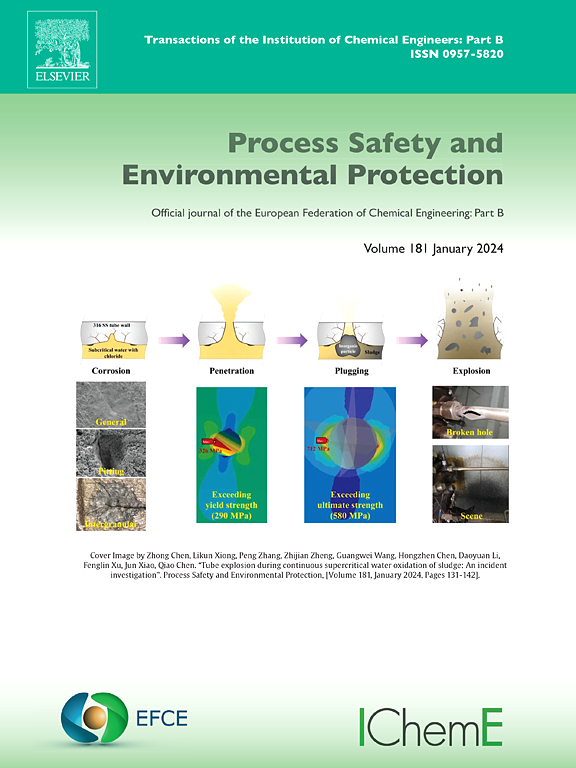Challenges in the production of livestock manure-derived biochar (LMB) for sustainable carbon neutrality: Evaluation of hazardous volatile organic compound (VOC) emission characteristics
IF 7.8
2区 环境科学与生态学
Q1 ENGINEERING, CHEMICAL
引用次数: 0
Abstract
Livestock manure-derived biochar presents an environmentally sustainable approach for managing livestock waste and achieving carbon neutrality through carbon sequestration. However, incomplete pyrolysis during biochar production may result in the retention of hazardous organic compounds, which can be emitted into the atmosphere during field application. In this study, biochar was produced at both lab- and pilot-scales under varying conditions, including manure type (cow and chicken), pyrolysis temperature (400°C and 700°C), and residence time (5–12 min). Emissions of volatile organic compounds (VOC) were evaluated across a temperature range of 35–280°C. Lab-scale results revealed that pyrolysis temperature had a more significant influence on VOC emissions than residence time. For example, total VOC concentrations measured at 50°C were 73.4 μg g–1 for biochar produced at 400°C, compared to 4.96 μg g–1 at 700°C. In a modeled field scenario, where 1 metric ton of pilot-scale biochar is mixed into soil (density 1.5 g cm–3; application rate 5 wt%), predicted ambient total VOC concentrations at 2 m height ranged from 8740 to 52,513 μg m–3. These levels far exceed the WHO’s indoor air quality target of 250 μg m–3, indicating substantial risk. Therefore, pyrolysis at or above 700°C and strict thermal management are essential for safe biochar production.
为实现可持续碳中和而生产畜禽粪便衍生生物炭(LMB)的挑战:有害挥发性有机化合物(VOC)排放特征的评估
畜禽粪便衍生的生物炭为管理畜禽废物和通过碳固存实现碳中和提供了一种环境可持续的方法。然而,在生物炭生产过程中,不完全热解可能导致有害有机化合物的滞留,这些化合物可能在现场应用时排放到大气中。在本研究中,生物炭在实验室和中试规模上分别在不同的条件下生产,包括粪肥类型(牛和鸡)、热解温度(400°C和700°C)和停留时间(5-12 min)。挥发性有机化合物(VOC)的排放在35-280°C的温度范围内进行了评估。实验结果表明,热解温度对VOC排放的影响比停留时间更显著。例如,在50°C下测量的总VOC浓度为73.4 μg g-1,而在700°C下测量的总VOC浓度为4.96 μg g-1。在模拟的田间情景中,将1公吨中试规模的生物炭混合到土壤中(密度1.5 g cm-3;施用量5 wt%),预测2 m高度的环境总VOC浓度为8740 ~ 52,513 μg m - 3。这些水平远远超过世界卫生组织的室内空气质量目标250 μg m-3,表明存在重大风险。因此,700°C或以上的热解和严格的热管理对于安全生产生物炭至关重要。
本文章由计算机程序翻译,如有差异,请以英文原文为准。
求助全文
约1分钟内获得全文
求助全文
来源期刊

Process Safety and Environmental Protection
环境科学-工程:化工
CiteScore
11.40
自引率
15.40%
发文量
929
审稿时长
8.0 months
期刊介绍:
The Process Safety and Environmental Protection (PSEP) journal is a leading international publication that focuses on the publication of high-quality, original research papers in the field of engineering, specifically those related to the safety of industrial processes and environmental protection. The journal encourages submissions that present new developments in safety and environmental aspects, particularly those that show how research findings can be applied in process engineering design and practice.
PSEP is particularly interested in research that brings fresh perspectives to established engineering principles, identifies unsolved problems, or suggests directions for future research. The journal also values contributions that push the boundaries of traditional engineering and welcomes multidisciplinary papers.
PSEP's articles are abstracted and indexed by a range of databases and services, which helps to ensure that the journal's research is accessible and recognized in the academic and professional communities. These databases include ANTE, Chemical Abstracts, Chemical Hazards in Industry, Current Contents, Elsevier Engineering Information database, Pascal Francis, Web of Science, Scopus, Engineering Information Database EnCompass LIT (Elsevier), and INSPEC. This wide coverage facilitates the dissemination of the journal's content to a global audience interested in process safety and environmental engineering.
 求助内容:
求助内容: 应助结果提醒方式:
应助结果提醒方式:


